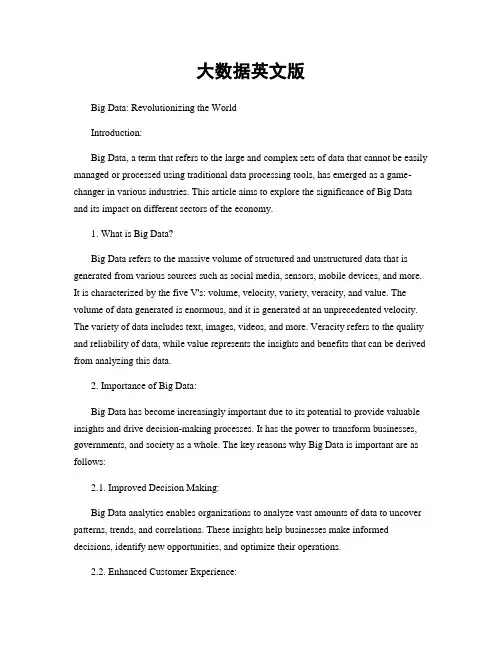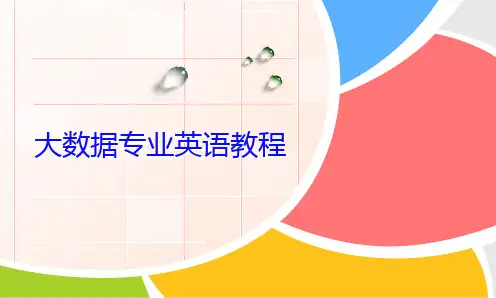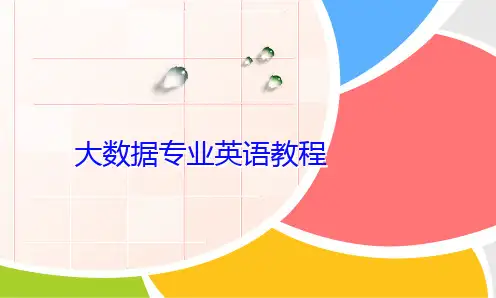《大数据专业英语》课件—12Data Security
- 格式:ppt
- 大小:1.75 MB
- 文档页数:20


大数据英文版Big Data: An IntroductionIntroduction:Big Data refers to the large and complex datasets that cannot be easily managed, processed, and analyzed using traditional data processing tools and techniques. With the rapid advancement in technology, organizations are now able to collect and store massive amounts of data from various sources such as social media, sensors, and online transactions. This data, when properly analyzed, can provide valuable insights and help businesses make informed decisions. In this article, we will explore the concept of Big Data in detail, its characteristics, and its importance in today's digital age.Characteristics of Big Data:1. Volume: Big Data is characterized by its sheer volume. Traditional databases are not capable of handling such large amounts of data. For example, social media platforms generate billions of posts, comments, and likes every day, resulting in massive amounts of data that needs to be processed and analyzed.2. Velocity: The speed at which data is generated is another characteristic of Big Data. Real-time data streams, such as stock market data or sensor data, need to be processed and analyzed quickly to extract meaningful insights. The ability to process data in real-time is crucial for businesses to respond promptly to changing market conditions.3. Variety: Big Data comes in various formats and types. It includes structured data, such as relational databases, as well as unstructured data, such as text documents, images, and videos. Additionally, Big Data can also include semi-structured data, such as XML or JSON files. The ability to handle and analyze different types of data is essential in deriving valuable insights.Importance of Big Data:1. Decision Making: Big Data analytics enables organizations to make data-driven decisions. By analyzing large datasets, businesses can identify patterns, trends, and correlations that can help them understand customer behavior, optimize operations, and develop targeted marketing strategies. For example, an e-commerce company can use Big Data analytics to analyze customer browsing patterns and preferences to offer personalized product recommendations.2. Innovation: Big Data has the potential to drive innovation in various industries. By analyzing large datasets, businesses can identify new market opportunities, develop innovative products and services, and improve existing processes. For instance, healthcare organizations can leverage Big Data analytics to identify disease patterns, predict outbreaks, and develop effective treatment plans.3. Cost Reduction: Big Data technologies can help organizations reduce costs and improve efficiency. By analyzing data from various sources, businesses can identify areas of wastage, optimize resource allocation, and streamline operations. For example, logistics companies can use Big Data analytics to optimize their delivery routes, reduce fuel consumption, and improve overall operational efficiency.Challenges of Big Data:1. Data Privacy and Security: With the increasing amount of data being collected, data privacy and security have become major concerns. Organizations need to ensure that they have robust security measures in place to protect sensitive data from unauthorized access or breaches. Additionally, they must comply with relevant data protection regulations and ensure that customer data is handled responsibly.2. Data Quality: The quality of data is crucial for accurate analysis and decision-making. Big Data often comes from various sources and may contain errors, inconsistencies, or missing values. Data cleansing and preprocessing techniques are necessary to ensure that the data is accurate, complete, and reliable.3. Skills and Expertise: Analyzing Big Data requires a specialized skill set. Data scientists and analysts need to have a deep understanding of statistical analysis, machinelearning, and data visualization techniques. Organizations need to invest in training and hiring skilled professionals to effectively leverage Big Data.Conclusion:Big Data has revolutionized the way organizations operate and make decisions. The ability to collect, store, and analyze massive amounts of data has opened up new possibilities for businesses across various industries. By harnessing the power of Big Data analytics, organizations can gain valuable insights, drive innovation, and improve operational efficiency. However, it is important to address the challenges associated with Big Data, such as data privacy and security, data quality, and the need for skilled professionals.。

大数据英文版Big Data: Revolutionizing the WorldIntroduction:Big Data, a term that refers to the large and complex sets of data that cannot be easily managed or processed using traditional data processing tools, has emerged as a game-changer in various industries. This article aims to explore the significance of Big Data and its impact on different sectors of the economy.1. What is Big Data?Big Data refers to the massive volume of structured and unstructured data that is generated from various sources such as social media, sensors, mobile devices, and more. It is characterized by the five V's: volume, velocity, variety, veracity, and value. The volume of data generated is enormous, and it is generated at an unprecedented velocity. The variety of data includes text, images, videos, and more. Veracity refers to the quality and reliability of data, while value represents the insights and benefits that can be derived from analyzing this data.2. Importance of Big Data:Big Data has become increasingly important due to its potential to provide valuable insights and drive decision-making processes. It has the power to transform businesses, governments, and society as a whole. The key reasons why Big Data is important are as follows:2.1. Improved Decision Making:Big Data analytics enables organizations to analyze vast amounts of data to uncover patterns, trends, and correlations. These insights help businesses make informed decisions, identify new opportunities, and optimize their operations.2.2. Enhanced Customer Experience:By analyzing customer data, organizations can gain a deeper understanding of their preferences, behavior, and needs. This allows them to personalize their offerings, improve customer service, and enhance overall customer experience.2.3. Cost Reduction and Efficiency:Big Data analytics can identify inefficiencies and areas of improvement within processes, leading to cost reductions and increased operational efficiency. For example, predictive maintenance can help prevent equipment failures, saving both time and money.2.4. Innovation and New Business Models:Big Data has the potential to drive innovation and the development of new business models. By analyzing data, organizations can identify emerging trends, market gaps, and untapped opportunities, leading to the creation of new products and services.3. Impact of Big Data on Different Sectors:Big Data has revolutionized various sectors, bringing about significant changes and improvements. Let's explore its impact on some key sectors:3.1. Healthcare:Big Data analytics has the potential to transform healthcare by improving patient outcomes, reducing costs, and enabling personalized medicine. By analyzing patient data, healthcare providers can identify patterns and predict diseases, leading to early diagnosis and timely interventions. Moreover, Big Data can help optimize healthcare operations, supply chain management, and resource allocation.3.2. Retail:Big Data analytics has revolutionized the retail industry by enabling personalized marketing, inventory optimization, and demand forecasting. By analyzing customer data, retailers can provide personalized recommendations, promotions, and offers, enhancing the customer experience. Additionally, Big Data analytics helps retailers optimize their inventory levels, reducing costs and minimizing stockouts.3.3. Finance:Big Data has transformed the finance industry by enabling better risk management, fraud detection, and customer insights. By analyzing financial data, banks and financial institutions can identify potential risks, detect fraudulent activities, and make informed lending decisions. Moreover, Big Data analytics helps financial institutions understand customer behavior, preferences, and needs, enabling them to provide personalized financial services.3.4. Transportation:Big Data analytics has revolutionized the transportation industry by improving efficiency, reducing congestion, and enhancing safety. By analyzing data from sensors, GPS devices, and traffic cameras, transportation companies can optimize routes, predict traffic patterns, and improve fleet management. Additionally, Big Data analytics enables the development of smart transportation systems, such as intelligent traffic lights and real-time public transportation updates.4. Challenges and Future Trends:While Big Data offers immense opportunities, it also presents several challenges. Some of the key challenges include data privacy and security, data quality, data integration, and talent shortage. Organizations need to address these challenges to fully leverage the potential of Big Data.Looking ahead, the future of Big Data seems promising. With the advancements in technology, such as artificial intelligence and machine learning, the capabilities of Big Data analytics will continue to expand. Moreover, the increasing adoption of Internet of Things (IoT) devices will generate even more data, further fueling the Big Data revolution.Conclusion:Big Data has become a driving force in today's digital era. Its ability to analyze large volumes of data and extract valuable insights has transformed various sectors, includinghealthcare, retail, finance, and transportation. By harnessing the power of Big Data, organizations can make informed decisions, enhance customer experiences, and drive innovation. However, addressing challenges such as data privacy and talent shortage is crucial to fully realize the potential of Big Data. As technology continues to evolve, the future of Big Data looks promising, opening up new possibilities for businesses and society as a whole.。



大数据专业词汇英语Key Terminology in Big Data Analytics.In the realm of big data analytics, a comprehensive understanding of key terminology is paramount toeffectively navigate and harness the vast sea of data.Here's a glossary of essential terms that will empower youto engage confidently in big data discussions and endeavors:Data Analytics: The systematic examination and interpretation of data to extract meaningful insights and patterns.Hadoop: An open-source software framework thatfacilitates distributed data processing, enabling the efficient handling of vast datasets across clusters of computers.Cloud Computing: A model for delivering computing services, including servers, storage, databases, networking,software, analytics, and intelligence, over the internet ("the cloud") to offer flexible and scalable access to computing resources.Data Lake: A centralized repository for storing vast volumes of raw, unstructured data in its native format, enabling flexible exploration and analysis.Data Warehouse: A structured repository of data, typically consisting of historical data, organized and optimized for querying and reporting purposes.Data Mining: The process of extracting hidden patterns and insights from large datasets through automated or semi-automated techniques.Machine Learning: A subset of artificial intelligence that enables computers to learn from data without explicit programming by identifying patterns and making predictions.Artificial Intelligence (AI): The simulation of human intelligence processes by machines, encompassing learning,reasoning, and problem-solving capabilities.NoSQL: A non-relational database management system designed to handle large volumes of unstructured or semi-structured data, offering flexibility and scalability.Hadoop Distributed File System (HDFS): A distributed file system that enables the storage of large data files across multiple commodity servers, providing fault tolerance and high availability.MapReduce: A programming model for processing and generating large datasets that is used in conjunction with Hadoop, where data is processed in parallel and aggregated to produce the final result.Business Intelligence (BI): A set of techniques and technologies used to transform raw data into meaningful and actionable information for business decision-making.Apache Spark: A fast and versatile open-source distributed computing engine that supports a wide range ofbig data processing tasks, including real-time stream processing.Extract, Transform, Load (ETL): The process of extracting data from disparate sources, transforming itinto a consistent format, and loading it into a target system for analysis.Data Governance: The policies, processes, and practices that ensure the reliability, integrity, and security of data throughout its lifecycle.Data Visualization: The graphical representation of data to facilitate the identification of patterns, trends, and insights.Data Scientist: A professional who possesses expertise in data analysis, machine learning, and statistical modeling, responsible for extracting insights and building predictive models from large datasets.Big Data: A term used to describe extremely large andcomplex datasets that traditional data processing softwareis inadequate to handle.Data Quality: The degree to which data conforms to predefined standards of completeness, accuracy, consistency, timeliness, and validity.Data Security: The measures and practices implementedto protect data from unauthorized access, use, disclosure, disruption, modification, or destruction.Open Data: Data that is made freely available to the public without any copyright, patent, or other restrictions, promoting transparency and innovation.Data Privacy: The regulations and ethicalconsiderations governing the collection, storage, use, and disclosure of personal data to protect individuals' privacy rights.Data Curation: The selection, acquisition, preservation, and documentation of data to ensure its availability,usability, and authenticity over time.Data Lakehouse: A unified data management platform that combines the scalability and flexibility of a data lakewith the structure and governance of a data warehouse, enabling both operational and analytical workloads.Modern Data Stack: A collection of cloud-based toolsand technologies that facilitate the collection, storage, transformation, and analysis of big data in a scalable and cost-effective manner.Data Fabric: An architectural approach that enables the integration and interoperability of data across diverse systems and environments to provide a unified andconsistent data experience.By understanding these key terms, you'll be well-equipped to navigate the ever-evolving world of big data analytics and leverage its transformative potential todrive informed decisions and achieve organizational success.。





大数据英文版Big Data: Unlocking the Power of DataIntroduction:In today's digital age, the amount of data generated is growing exponentially. This vast amount of data, known as big data, holds immense potential for businesses and organizations across various industries. Harnessing the power of big data can provide valuable insights, drive innovation, and improve decision-making processes. In this text, we will explore the concept of big data, its benefits, challenges, and its impact on various sectors.Definition of Big Data:Big data refers to the massive volume of structured and unstructured data that is generated from various sources such as social media, sensors, machines, and transactional systems. It encompasses three main characteristics known as the three Vs: volume, velocity, and variety. Volume refers to the large amount of data generated, velocity represents the speed at which data is generated and processed, and variety refers to the different types and formats of data.Benefits of Big Data:1. Improved Decision-Making: Big data analytics enables organizations to analyze vast amounts of data in real-time, providing valuable insights that can drive informed decision-making. By identifying patterns, trends, and correlations, businesses can make data-driven decisions that lead to improved efficiency and competitiveness.2. Enhanced Customer Experience: Big data analytics allows organizations to gain a deeper understanding of their customers by analyzing customer behavior, preferences, and feedback. This enables businesses to personalize their offerings, improve customer service, and deliver a seamless customer experience.3. Increased Operational Efficiency: Big data analytics can optimize operational processes by identifying bottlenecks, inefficiencies, and areas for improvement. By analyzing large datasets, organizations can streamline operations, reduce costs, and enhance productivity.4. Innovation and New Product Development: Big data provides valuable insights into market trends, customer needs, and emerging technologies. This information can fuel innovation and drive the development of new products and services that meet the evolving demands of customers.Challenges of Big Data:While big data offers numerous benefits, it also presents several challenges that organizations must overcome to fully leverage its potential:1. Data Security and Privacy: With the proliferation of data, ensuring the security and privacy of sensitive information becomes crucial. Organizations need to implement robust security measures and comply with data protection regulations to safeguard data from unauthorized access and breaches.2. Data Quality and Integration: Big data often comes from various sources and in different formats, making data quality and integration a significant challenge. Data cleansing, standardization, and integration processes are essential to ensure accurate and reliable insights.3. Scalability and Infrastructure: Handling and processing large volumes of data requires scalable infrastructure and advanced technologies. Organizations need to invest in suitable hardware, software, and IT infrastructure to manage and analyze big data effectively.4. Skills and Expertise: The field of big data analytics requires specialized skills and expertise. Organizations need to hire and train professionals who possess the necessary knowledge in data science, statistics, programming, and machine learning to extract meaningful insights from big data.Impact of Big Data across Industries:1. Healthcare: Big data analytics is revolutionizing the healthcare industry by enabling predictive analytics, personalized medicine, and improved patient outcomes. By analyzing patient data, medical records, and clinical research, healthcare providers can identify patterns, predict disease outbreaks, and develop targeted treatment plans.2. Retail: Big data analytics helps retailers understand customer behavior, preferences, and buying patterns. This information allows retailers to optimize inventory management, personalize marketing campaigns, and enhance the overall shopping experience.3. Finance: Big data is transforming the financial sector by enabling fraud detection, risk assessment, and algorithmic trading. By analyzing vast amounts of financial data, organizations can identify fraudulent activities, assess creditworthiness, and make data-driven investment decisions.4. Manufacturing: Big data analytics is enhancing manufacturing processes by optimizing supply chain management, improving production efficiency, and reducing downtime. By analyzing sensor data, machine logs, and customer feedback, manufacturers can identify areas for improvement and implement proactive maintenance strategies.Conclusion:Big data has emerged as a game-changer in today's data-driven world. By harnessing the power of big data analytics, organizations can unlock valuable insights, drive innovation, and gain a competitive edge. However, it is essential to address the challenges associated with big data, such as data security, quality, scalability, and skills. As big data continues to evolve, its impact across industries will only grow, transforming the way organizations operate and make decisions.。
大数据专业英语教程课程设计课程简介本课程旨在帮助大数据专业的学生提高英语水平,以便更好地理解和应用国际上最新的大数据技术和理论。
本课程将涵盖大数据领域中的常用英语词汇、短语、概念、方法和技术,同时将探讨大数据背后的商业和社会价值。
课程目标•让学生掌握大规模数据分析的理论和实践•提高学生的英语听说读写能力•帮助学生理解大数据应用的商业和社会价值授课方式本课程采用课堂教学、案例分析、小组讨论等多种教学方式。
课堂上将重点侧重于学生的交互式学习和实践技能培养。
课程内容第一章:大数据概述本章将对大数据的定义、历史、来源、挑战和应用等方面进行介绍。
- Key vocabulary: big data, data analytics, data volume, data velocity, data variety - Key concepts: data explosion, data processing, data governance, data security, data privacy第二章:数据挖掘与分析本章将介绍数据挖掘和分析的方法和实践。
- Key vocabulary: data mining, predictive modelling, regression analysis, clustering analysis, decision tree - Key concepts: data visualization, exploratory data analysis, feature engineering, data preprocessing, data cleaning第三章:机器学习和人工智能本章将探讨机器学习和人工智能的基础知识、算法和应用。
- Key vocabulary: machine learning, deep learning, artificial intelligence, neural network, support vector machines - Key concepts: supervised learning, unsupervised learning,transfer learning, natural language processing, computervision第四章:数据管理和存储本章将介绍数据管理和存储的基本原则和技术。